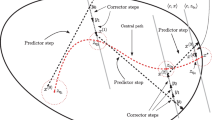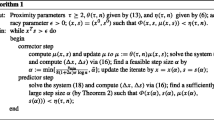Abstract
Recently, we have extended SDP by adding a quadratic term in the objective function and give a potential reduction algorithm using NT directions. This paper presents a predictor–corrector algorithm using both Dikin-type and Newton centering steps and studies properties of Dikin-type step. In this algorithm, when the condition K(XS) is less than a given number K 0, we use Dikin-type step. Otherwise, Newton centering step is taken. In both cases, step-length is determined by line search. We show that at least a constant reduction in the potential function is guaranteed. Moreover the algorithm is proved to terminate in O\((\sqrt n \)log (1/ε)) steps. In the end of this paper, we discuss how to compute search direction (ΔX,ΔS) using the conjugate gradient method.
Similar content being viewed by others
References
F. Alizadeh, Interior point methods in semidefinite programming with application to combinatorial optimization, SIAM J. Opt. 5 (1995) 13–51.
F. Alizadeh, J.-P.A. Haeberly, M.L. Overton, Primal-dual interior point methods for semidefinite programming: Convergence rates, stability and numerical results, SIAM J. Opt. 8 (1998) 746–768.
K. Fujisawa, M. Kojima and K. Nakata, Exploiting sparsity in primal-dual interior-point methods for semidefinite programming, Math. Programming 79 (1997) 235–253.
G.H. Golub and C.F. Van Loan, Matrix Computations, 3rd ed. (Johns Hopkins University Press, Baltimore, 1996).
B. Jansen, C. Roos, T. Terlaky and J.P. Vial, Primal-dual algorithms for linear programming based on the logarithmic barrier method, J. Optim. Theory Appl. 83 (1994) 1–26.
J. Jiang, A long step primal-dual path following method for semidefinite programming, Operations Research Letters 21 (1998) 53–61.
E. De Klerk, Interior point methods for SDP, Ph.D. thesis, Delft University of Technology, Delft, The Netherlands (1997).
M. Kojima, S. Shindoh and S. Hara, Interior-point methods for the monotone semidefinite linear complementarity problems, SIAM J. Opt. 7 (1997) 86–125.
A. Nemirovskii and P. Gahinet, The projective method for solving linear matrix inequalities, Math. Programming, Series B 77 (1997) 163–190.
Y. Nesterov and M.J. Todd, Self-scaled barriers and interior-point methods for convex programming, Mathematics of Operations Research 22 (1997) 1–42.
Y. Nesterov and M.J. Todd, Primal-dual interior-point methods for self-scaled cones, SIAM J. Opt. 8 (1998) 32–364.
J.W. Nie and Y. Yuan, A potential reduction algorithm for an extended SDP problem, Science in China 43 (2000) 35–46.
H.D. Qi and X. Chen, On stationary points of merit functions for semi-definite complementarity problems, Report, ICMSEC, Chinese Academy of Sciences (1997).
J.F. Sturm and S. Zhang, Symmetric primal-dual path following algorithms for semidefinite programming. Applied Numerical Mathematics 29 (1999) 301–315.
M.J. Todd, K.C. Toh and R.H. Tütüncü, On the Nesterov-Todd direction in semidefinite programming, SIAM J. Opt. 8 (1998) 769–796.
P. Tseng, Search directions and convergence analysis of some infeasible path-following methods for the monotone semi-definite LCP, Optimization Methods and Software 9 (1998) 245–268.
Y. Ye, Interior Point Algorithm Theory and Analysis (Wiley, New York, 1998).
Y. Yuan, Numerical Methods for Nonlinear Programming (Shanghai Sci. Tech. Publishers, Shanghai, 1993) (in Chinese).
Y. Zhang, On extending primal-dual interior-point algorithms from linear programming to semidefinite programming, SIAM J. Opt. 8 (1998) 365–386.
Q. Zhao, S.E. Karische, F. Rendl and H. Wolkowicz, Semidefinite programming relaxations for the quadratic assignment problem, CORR Report 95-27, Department of Combinatorics and Optimization, University of Waterloo, Waterloo, Ontario, Canada (1996).
Author information
Authors and Affiliations
Rights and permissions
About this article
Cite this article
Nie, JW., Yuan, YX. A Predictor–Corrector Algorithm for QSDP Combining Dikin-Type and Newton Centering Steps. Annals of Operations Research 103, 115–133 (2001). https://doi.org/10.1023/A:1012994820412
Issue Date:
DOI: https://doi.org/10.1023/A:1012994820412




